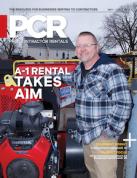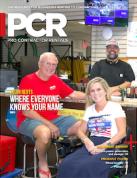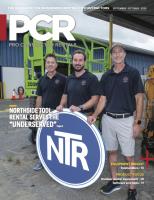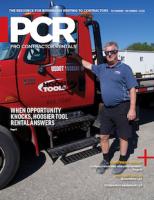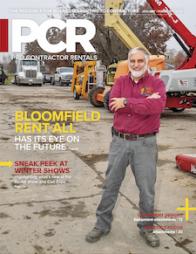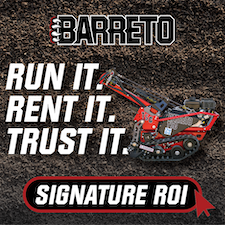Industry outlook: Telehandlers reach new heights
Rental customers are demanding greater versatility and more capabilities in new models.
Telehandlers are becoming one of the most popular pieces of equipment in rental fleets. From the excavation phase to building finish, they are likely going to be used in every step of the construction process.
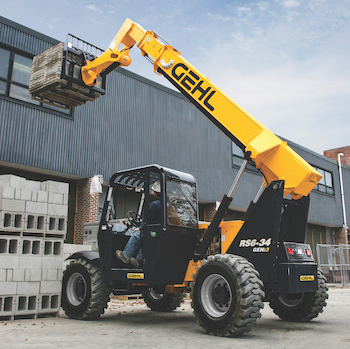 |
Their first-out/last-back rental status means these units can be great additions to any rental fleet.
As customers get more comfortable using these versatile tools, they are looking for more ways to use them, so manufacturers are rolling out new models that can fit on a variety of job sites and do more than lift-and-carry tasks.
Pro Contractor Rentals asked leading telehandler manufacturer experts how they see telehandlers increasingly fit in rental operations and how rental centers can make these units even more profitable for their operations.
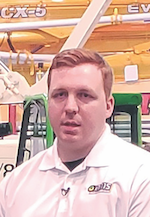 |
| Austin Bailey, National Territory Sales Manager, Applied Machinery Sales |
Safety systems are key rental components
One of the major trends in telehandler development is the addition of more safety systems such as overload protection. Although Merlo has been doing this with its telehandlers for years, more customers are beginning to realize and appreciate just how beneficial these safety features can be and, as a result, request machines with these features. Merlo also designs all of its telehandlers with a low-pivot boom. We see this as a safety feature because it allows the operator to have a full 360-degree view of his or her surroundings from inside the cab while carrying a load around a job site. This helps prevent accidents, such as collisions.
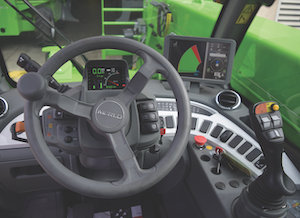 |
|
Increasingly, manufacturers are adding load indicatiors that graphically share load safety information with the operator throughout the lift and carry cycle. |
Rental centers and dealerships can increase demand and ROI on units with the features mentioned above by explaining to their customers the benefit of these features and how improved safety can increase overall efficiency and productivity.
If a telehandler is used with a man basket, the ANSI reforms affecting MEWPs come into play. Rental centers will need to educate their users on the updated safety requirements and how to use the equipment. Merlo telehandlers with the man basket option already have these required safety features, such as gates instead of chains across basket access points and load sensors in place.
 |
|
Josh Taylor, Genie Product Manager, Terex AWP |
Telematics use becoming more common
One technology that is being adopted industry-wide, across all rental products, is telematics. Telematics allows the fleet owner to see real-time data about the machine while it is on the job site. This improves the rental house’s ability to track service and maintenance needs, optimize delivery and pickup routes and generally become more efficient in a way that was not possible before. Many large rental companies have already taken advantage of this technology and it is becoming more common among independents and smaller rental houses.
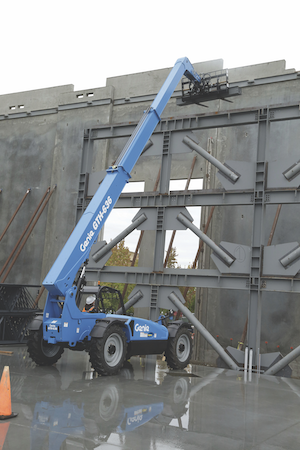 |
|
Customers are constantly looking for solutions that provide the same level of productivity and return with lower complexity. |
In the North American rental market, telehandlers generally enjoy very high utilization due to their versatility. The key to having the right size machines in your fleet is to understand your customer base and what types of projects are happening in your area. In terms of reducing cost of ownership, following regular maintenance schedules is the best way to prevent unwanted downtime.
Customers are constantly looking for solutions that provide the same level of productivity and return with lower complexity. The Genie Lift Connect telematics program helps customers better understand their fleet and helps them drive improvements in their businesses.
From a regulatory standpoint, the latest revision of ANSI/ITSDF B56.6 (2016) provided some new guidelines around the use of personnel work platforms (PWPs) with telehandlers. Users should be aware of the new requirements and make sure that they are compliant. A copy of the standard is available free of charge from the Industrial Truck Standards Development Foundation (ITSDF) at www.itsdf.org.
 |
|
Paul Jensen, Product Manager, Haulotte U.S. |
Safety features and versatility drive telehandler acceptance
Telehandlers are the multi-tool on a job site that guarantees increased productivity and safety whenever the machine is put to use. A single telehandler can function as a forklift, crane, earth mover, log or pipe grapple and more. This versatility means job sites can have fewer machines being delivered to the site and free up space for work instead of storing idle machinery. As more accessories are developed for telehandlers, we see them used on more projects, staying on site longer, and reducing their idle times.
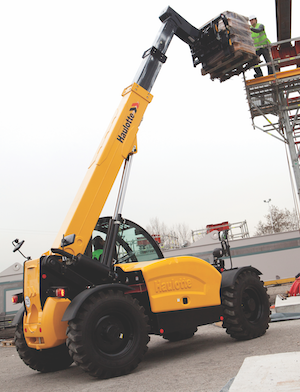 |
|
Haulotte telehandlers come standard with a Load Moment Indicator (LMI) that intelligently supports operator safety. |
Equipment safety features are trending in the construction industry. Every Haulotte telehandler comes standard with a Load Moment Indicator (LMI) that intelligently supports operator safety. The LMI takes the guesswork out of operating the machine safely at every stage of the lift cycle. Using a green-to-red LED light scale, the LMI gives continuous feedback to the operator about the safety of the load as it is lifted and carried and cuts off machine movement to prevent tipping events.
Haulotte has been getting great interest in the LMI feature from safety professionals on job sites. They appreciate the increased safety of the machine, preventing unsafe movements instead of an operator relying on load charts and making a best guess of how to position the load. Haulotte engineers predict there will be more demand for safety features like the LMI that reduce safety risks by making machines smarter.
Telehandler versatility makes them a first-on/last-off the project, long-term rental. The best way to increase demand and increase the length of each rental is to make the machine as usable as possible during all phases of the project. The more options available to the user, the more often the machine will be used on the job site. By reducing the time the machine sits idle on the project, the value of the machine increases to the contractor and utilization goes up for the rental store.
As idle time goes down, operators spend more time in the cab operating the machine. Haulotte cabs are built to be comfortable and support all-day operation. Easy-to-see and understand dashboard symbols, ergonomic seat adjustments and suspension, heating and air conditioning and an intuitive joystick controller reduces fatigue and increases productivity on long shifts.
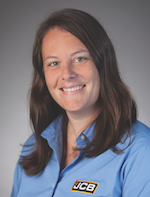 |
|
Rebecca Yates, Telehandler Product Manager, JCB North America |
Increasing specialization
Over the past 40 years, and especially in the past five years, telehandlers have become increasingly specialized with customers demanding features and capabilities that are tailored to their industry – and sometimes even a specific application within an industry – to maximize productivity, efficiency and safety.
For example, JCB now offers non-marking tires for telehandlers in all sizes – compact up to 14,000 pounds – to meet the requirements of companies in the entertainment industry.
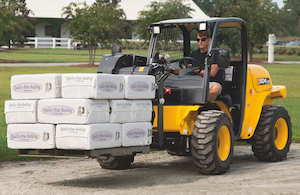 |
|
Telehandlers have become more specialized, with customers demanding features and capabilities that are tailored to their industry — and sometimes even a specific application within an industry — to maximize productivity, efficiency and safety. |
There is strong and growing demand in many market segments for telehandlers that require no exhaust aftertreatment. JCB offers several no-aftertreatment machines including the 74 horsepower 512-56 Loadall telehandler, which is world’s first 12,000-pound machine that doesn’t require DPF, DEF or engine aftertreatment systems. The benefits of no-aftertreatment machines are numerous: reduced operating costs; no need for diesel exhaust fluid (DEF) or high-temperature lubricants and costly replacement diesel particulate filters. No-aftertreatment machines also enable higher productivity by reducing daily check requirements and eliminating productivity-sapping regeneration cycles.
JCB is experiencing increased demand across all machine sizes, from its small telehandlers, such as the 5000-pound, 20-foot lift 505-20TC, to JCB’s largest machine, the 12,000-pound, 56-foot lift 512-56 model.
The popularity of a particular size of telehandler is largely determined by the geography and application. For a city and urban construction jobs, the 508-66 is a popular choice as its 66 feet of lift height, no-aftertreatment 74-horsepower engine and small footprint reduce the need for road lane closures. Where the application demands maximum versatility and maneuverability, a compact telehandler such as the JCB 505-20TC can be used on job sites of all sizes and its skid steer coupler front-end allows use of an extensive list of attachments.
At the other end of the scale, JCB’s 10,000- and 12,000-pound telehandlers are often chosen for their ability to lift and place pallets of brick or block higher than smaller machines. JCB has six models in the 10,000- to 12,000-pound class, including the 510-42, a machine with 10,000-pound capacity that requires no outriggers; and the 512-56, the world’s only 12,000-pound telehandler that requires no DPF, no DEF and no engine aftertreatment.
Telehandlers are versatile, easy to use and efficient in a variety of applications. They excel at moving material from point A to point B, especially where height and/or significant weight add complexity to the task. For this reason, telehandlers have long been used on construction job sites. A lift and place-type telehandler such as the JCB 512-56, for example, is commonly used on construction sites to move and lift materials onto scaffolding.
Telehandlers are also available in a range of sizes and capacities to match the rental customer’s application. JCB, for example, offers 16 models for the construction industry. Together these factors contribute to high utilization by the rental customer and high returns for the rental company.
For optimal ROI, rental operations should match telehandler inventory with customer demand, which will be determined largely by the store location and focus. For a rental operation in a city or urban environment, there is also strong demand for telehandlers in the 10,000-pound class, which can handle most standard pallet loads at height, including brick or block.
JCB tool carrier-style telehandlers provide rental customers with more options as these models can be used for pallet work and material handling. This versatility creates increased renter demand and often results in the customer requiring fewer machines, but renting those machines for longer periods, which enhances the efficiency of the rental operation.
Telematics systems continue to grow in popularity and priority for telehandler owners, and particularly for rental fleet managers who benefit from real-time, remote access to important machine information.
The JCB LiveLink telematics system, for example, provides information about machine status, battery life and fuel usage. This can help efficiently schedule preventive maintenance to reduce maintenance costs and downtime. LiveLink can also report on machine location, movement and activity with curfew and geofence alerts to protect the owner’s investment against unauthorized use or theft. To provide the most value to all users of JCB telehandlers, LiveLink is now a standard feature.
 |
|
John Boehme, Senior Product Manager, JLG |
Megatrends driving telehandler development
Four trends taking place in the world are profoundly affecting the ongoing design and development of telescopic handlers as well as other equipment offered by rental centers:
Urbanization: Job sites are becoming tighter and more crowded and telehandlers must be able to fit on these job sites. Further, these units are increasingly used in enclosed areas, which means they must meet tight regulations for emissions and noise levels. That means electrically powered units will be in greater demand.
Connectivity: The Internet of Things (IOT) is changing how we interact with equipment. The result is smarter equipment that can affect how rental centers can better manage their fleets, regardless of where the machines are working. The data gathered from a wide variety of machines can help improve machine uptime and productivity across the fleet.
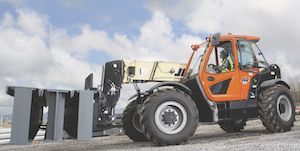 |
|
Four trends are affecting telehandler demand: urbanization, connectivity, greater need for productivity and globalization.Telehandler manufacturers must look at all four trends to assure their new models address the challenges and opportunities these trends present, says John Boehme, JLG senior product manager. |
Greater need for increased productivity: In construction, achieving greater productivity has been a challenge, but successful contractors and rental centers need to realize higher productivity from their assets and crews. Further, increasing job site safety goes hand-in-hand with that increased productivity. It’s imperative that workers go home the same way they arrived at work every day.
As telehandler manufacturers, we must look at our equipment differently. It’s not about the machine, instead it is about solutions those machines offer.
We must look at today’s unmet needs as well as needs in five or 10 years from now. For example, customers say they need a telehandler that reaches higher. It’s our job to look deeper and find out why they need to reach higher. What types of jobs are they doing that require a higher-reaching machine? Are there other ways to meet that need?
Machines outfitted with SmartLoad Technology fill some of those unmet needs. This technology doesn’t allow the operator to violate load capacity boundaries throughout the lift cycle. That helps operators use equipment more confidently and safely. It also helps protect fleet assets, preventing users from damaging the equipment by overloading.
Globalization: Today’s equipment is becoming more globalized. While equipment companies must consider specific job needs in different regions of the world, looking at the specific needs across the globe will lead to machines with more consistent features that can help improve production efficiency.
Rental centers can best help their customers by asking questions. What are the potential renter’s unmet needs? Would those needs be best met with a 7,000 or 12,000 pound-capacity unit? Renters tend toward to no-frills models, looking for the lowest rental cost possible. Instead, rental centers must strive to educate users that models with smarter features can help them operate more productively and safely. Options such as backup alarms, on-board cameras and other sensors can give operators a 360-degree view of the machine. It greatly affects productivity and safety.
For rental companies, total cost of operation drives profitability. It’s not just the acquisition cost; it’s how long the machine will be able to work, how fast problems can be diagnosed and how fast replacement/repair parts can be obtained that affect total cost of ownership.
Total cost of ownership gets more important every day, and it’s imperative that rental centers get granular with customers, fully understanding their unmet needs and providing the right unit that fills those needs at a price that offers the best value to the customer.
 |
|
Steve Kiskunas, Global Telescopic Handler Product Manager, Manitou |
Smaller units gaining rental popularity
Modern telescopic handlers exist to solve the “How do I move my building materials from here to there?” problem.
Over the past 50 years, telehandlers have evolved with updated controls, capacity, engines and operator experiences. Some of the recent changes to telescopic handlers were to comply with government EPA engine emission requirements. The implementation of new engine exhaust technology has led rental companies to train customers on adding DEF fluid and take care of DPF filter cleaning.
With new product offerings by Gehl, the most popular rental telescopic handlers are now available with two different horsepower and emission control systems. The standard Gehl
GEN:3 models – RS6-34, RS8-42, RS8-44, RS10-55 – offer 120 horsepower with DEF and SCR systems. The Mark74 series offers those same four models with a 74-horsepower and a DOC filter only. The lower 74-horsepower units are a simpler solution for rental customers with reduced maintenance and work well for customers who do not require high-speed, high-torque or high-altitude operation available with the higher horsepower machines. Without the higher horsepower emission control systems, the Mark74 units have a lower acquisition cost for improved ROI.
The technology incorporated into the Gehl GEN:3 and Mark74 units feature a single multi-function control joystick with transmission direction and speed control. This allows operators to keep a hand on the steering wheel and the other hand on the single control while driving the machine. The controls layout is intuitive and easy for rental customers to learn.
One of the latest trends in the telehandler market is the need for smaller models that can work in more confined areas. Gehl launched the ultra-compact Gehl RS4-14 telehandler in 2018 to great success, providing easy transportation and use, with a full-sized operator cab on a machine just 4 feet 11 inches wide. With the ability to work in confined areas where larger telehandlers cannot fit, this ultra-compact telehandler easily picks up most palletized loads with a maximum lift capacity of 4,400 pounds.
Rental centers that want to improve ROI on telehandlers, regardless of size, should look for a way to increase utilization of the machines. Finding ways for the machine to do more tasks for the customer with additional attachments will provide greater utility for the customer and longer rental periods for the rental center.
The telescopic handler can perform exceptionally well as a rough-terrain forklift, but with the addition of a sweeper it becomes a site clean-up tool, or with a bucket, it can move light materials and trash.
In addition, increasing the usage of attachments designed for moving building trusses or digging holes provides rental centers with an increase in telescopic handler usage and revenue as well as solving additional obstacles for rental customers.
 |
|
Mitch Fedie, Marketing Manager, Pettibone |
Design for operator confidence
The key goal in telehandler development at Pettibone is giving the operator full confidence in the machine and keeping safety at the forefront. Pettibone has always been known for providing very smooth controls to eliminate jerky movements when lifting and landing loads and engineers continually work to make even more improvements in that area.
Pettibone telehandler designers put great thought into machine stability and the pants-in-the-seat feel for the user. They want to ensure the operator still feels secure when pushing the machine to its top-reach or full-load capacities. They are exceptional at crunching the numbers and making sure the machine is optimally safe. That provides peace of mind to everyone, from the rental houses to the end users.
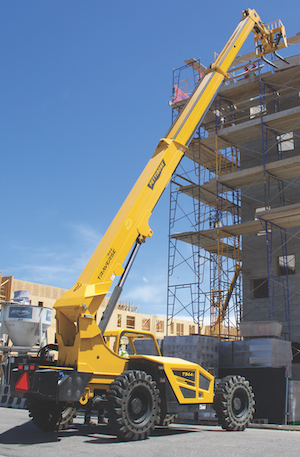 |
|
Pettibone engineers carefully design telehandlers with operators in mind, making sure they feel confident when pushing units to their full capacity. |
Visibility is key component for operator comfort. The Pettibone X-Series design was optimized to provide clear sightlines. The main blind spot for a telehandler operator is typically when looking back toward the curbside, and Pettibone engineers designed its machines to dramatically increase visibility in that particular area. Back-up cameras are more common today, but it’s still important to allow the operator to see firsthand when maneuvering.
As far as ROI, Pettibone continues to provide longer-lasting machines. Instead of the industry norm of four to five years before flipping a machine, Pettibone rental fleets often last six to 10 years or longer. It’s a stronger design that may cost a little more on the front end, but it’s been proven to last for the long haul.
Further, the new Pettibone X-Series machines offer improved serviceability. The boom design was completely redone for added strength and now it’s also faster to change wear pads and service hydraulic hoses. Common maintenance items like grease points and filters are more accessible as well. When a machine comes off rent, it can be serviced and turned around faster to help keep utilization rates high.
Technology continues to play a larger role. Many European telehandlers have load sensing and that could become a more prominent feature in the North American market. Telematics are increasingly being used so rental centers know where their machines are being used and how long they’re running on the job. They can also get alerts for service warnings for minor things like low DEF levels or for more significant issues, in which case the rental center could remotely shut down the machine to avoid problems from becoming even more serious.
 |
|
Braden Spence, Product Manager, Skyjack |
Where power and versatility meet
A trend Skyjack identified in 2018 has carried over into 2019 as well and we’re continuing to see manufacturers adopt smaller horsepower engines in larger telehandlers. For example, Skyjack’s SJ1044 TH and SJ1056 TH use smaller engines that don’t require DPF, DEF or other active exhaust aftertreatments.
Skyjack was one of the first manufacturers to adopt this methodology by using Smartorque technology found in the Skyjack TH Series and the approval of Tier 4-Final emission changes in 2015. Smartorque uses a low-horsepower, high-torque engine that delivers similar torque and hydraulic performance of higher horsepower engines.
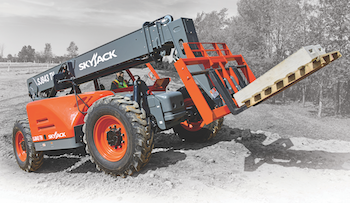 |
|
More operators are turning to telehandlers for a wider range of applications due to the versatility provided by the wide range of attachments, which helps maximize the utilization of this first-on/last-off-the-job-site piece of equipment. |
There has been an increasing demand within the compact telehandler market for units with lift capacities up to 6,000 pounds. They are now the second highest in demand in North America. Skyjack addresses that demand with its SJ519 TH, which offers a small footprint, 5,500 pounds of lift capacity and provides a generous amount of space in the operator’s cab.
More operators are turning to telehandlers for a wider range of applications due to the versatility provided by the wide range of attachments, which helps maximize the utilization of this first-on/last-off the job site piece of equipment.
Like all Skyjack products, telehandlers are designed specifically for rental operations. That means ensuring these units can withstand the harsh environment where these machines are used, creating a true rental product with an exceptional lifecycle. There are a number of factors to consider, but typically the ROI on telehandlers can be broken down and viewed in two ways:
Machine versatility: The wider the variety of tasks the equipment can perform, the higher utilization it receives and thus the more value it provides to the rental company.
Serviceability: Time spent in off-rent can add up quickly, so a machine that provides maximum uptime through an easily serviceable design can be a key component in increasing a rental company’s ROI.
An increased number of rental fleets are equipping their entire lineup – telehandlers included – with telematics solutions like Skyjack’s Elevate. This remote visibility will be a game changer for fleet managers as they’ll be able to see the health of the engine, CANbus faults and machine utilization remotely. While this doesn’t change the overall makeup of the machine and how it performs for operators, it provides fleet managers with the opportunity to improve service processes, which in turn saves the rental company time, money and gets units back to work sooner.
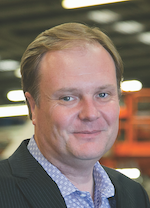 |
|
Matthew Elvin, CEO, Xtreme Manufacturing and Snorkel |
Greater capacity trend
A trend that we are seeing is the request for greater capacity. More customers are seeing the productivity and maneuverability benefits of choosing telehandlers in applications where they would have traditionally used cranes, and as such, they have the desire to lift heavier load.
Additionally, customers are requesting load management systems on telehandlers. Owners see the long-term benefits of these systems which reduce overloads that can lead to structural failures and increased maintenance costs.
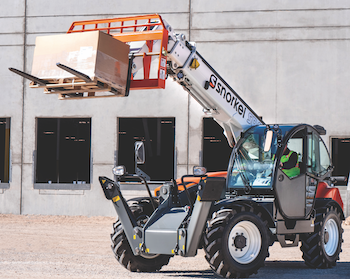 |
|
Increasing numbers of customers are seeing the productivity and maneuverability benefits of choosing telehandlers in applications where they would have traditionally used cranes. |
To increase general demand for telehandlers, rental companies can invest in a wide range of attachments so telehandlers can be used in a wider range of applications. Offering a selection of attachments can also help to increase ROI through higher utilization and the ability to charge rental for the attachment itself.
Rental companies can also look to invest in telehandlers that are user friendly. Telehandler operators often spend most of their working hours in the cab, so their feedback about ease of use and comfort often play a part in shaping which brands and models of telehandlers customers demand from rental companies in future.
Xtreme telehandlers have been designed with an electric over hydraulic system that lets the operator fine-tune function and speed to the application. With an on-board control system and a parabolic association between the joystick position and operational speed, operators have roughly twice the precision over movements at low speeds but have full speed when they move the joystick to full position.
The OSHA regulation that requires crane operator certification has encouraged more owners to consider telehandlers for pick-and-place applications. As load moment control or indicating systems become less costly, more owners are going to rely on that technology.
This article appeared in the November-December 2019 issue of Pro Contractor Rentals magazine.
© 2019 Urbain Communications LLC. All rights reserved.



